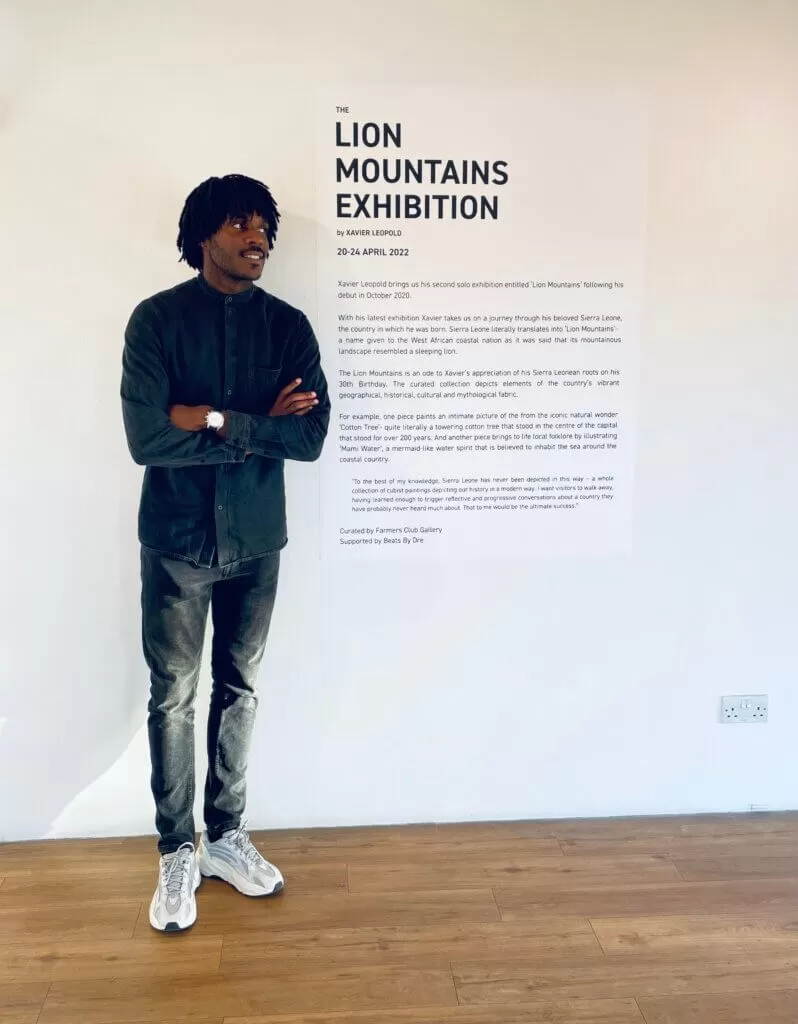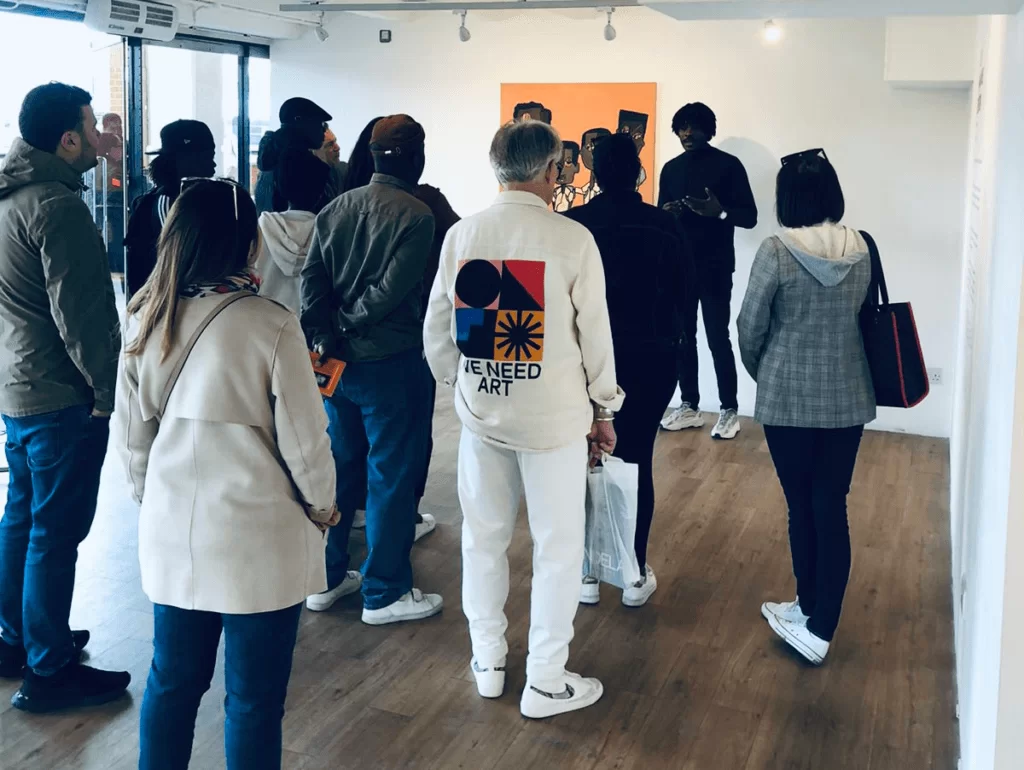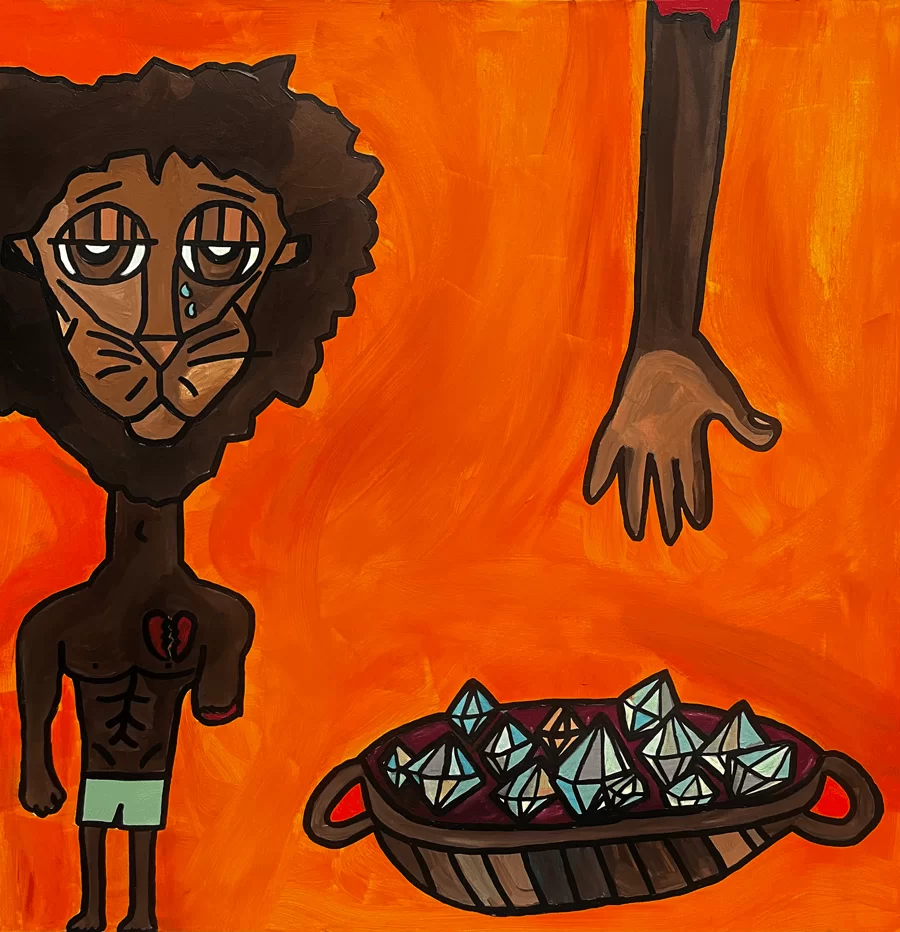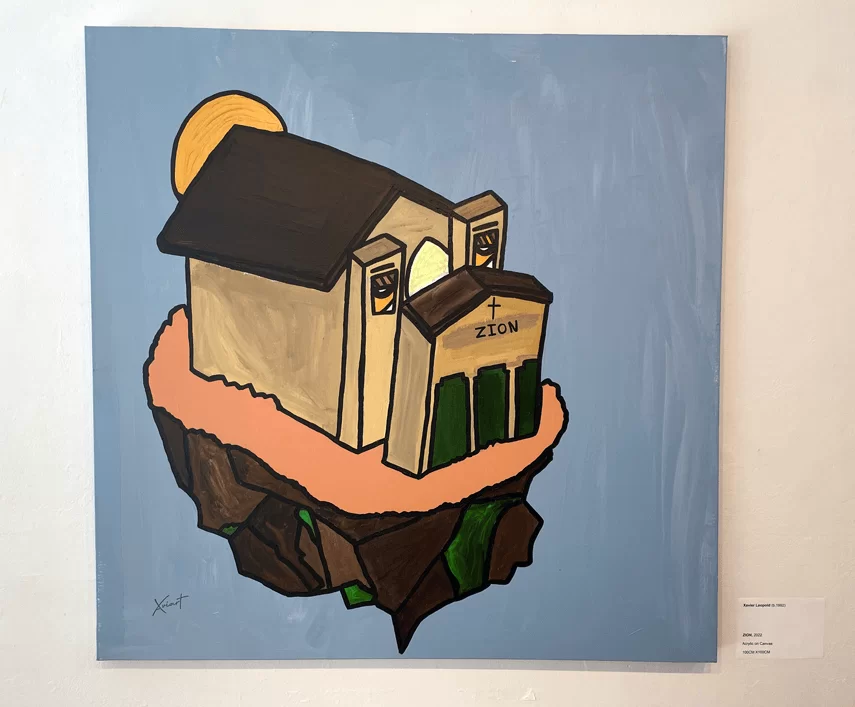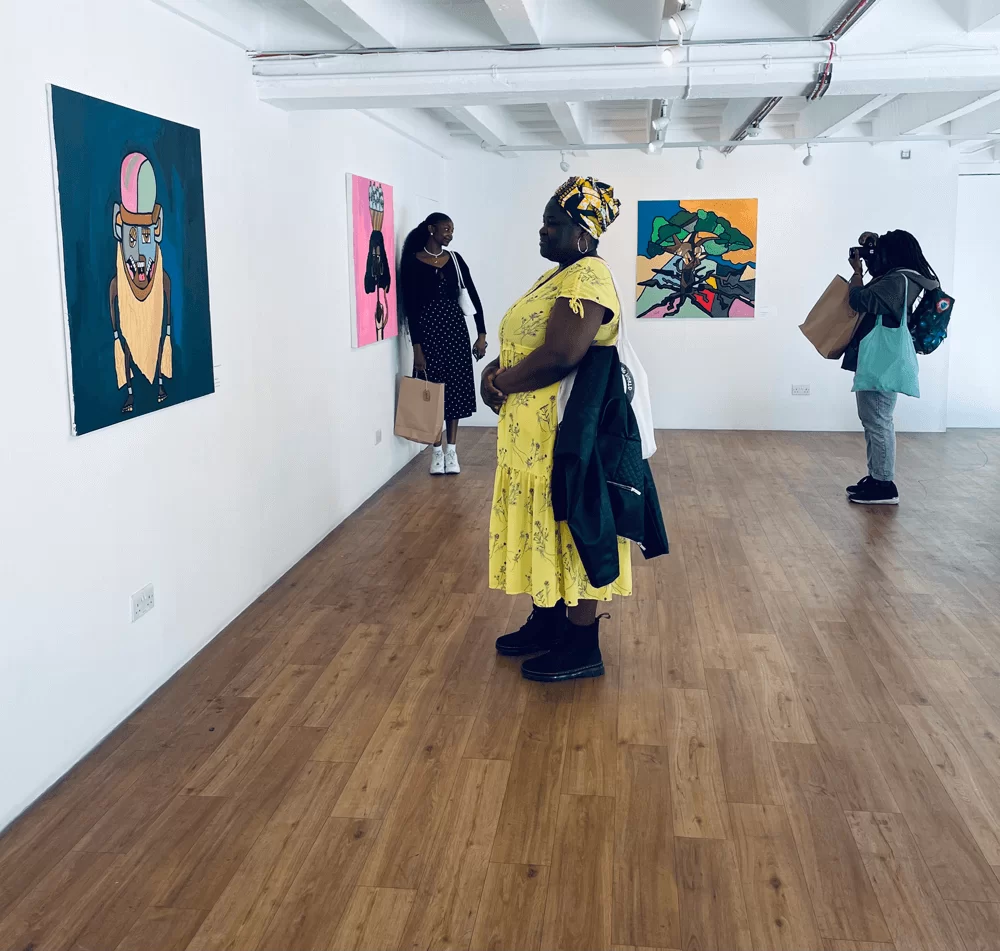Sculptor Jacques Lipchitz expressed, “Cubism is not a formula, it is not a school. Cubism is a philosophy, a point of view in the universe”. These sentiments hold the truth for London-based artist Xavier Leopold as he depicts his perspective on heritage, culture and the world influenced by geometric shapes and forms of Cubism and the modernist style of abstraction.
Having survived the uproar of a pandemic, Leopold discovered his creativity. This new outlook inspired him to examine his purpose, ultimately leading him to conceive a distinctive aesthetic.
A beautiful thing for me through art; I’ve found my power that helps me dive into a new world
Xavier Leopold
Leopold’s canvases are full of colour, bold lines and shapes, with his figure’s the focal point, posed with eyes that glow in the dark, a trait throughout his work—symbolising his fascination with the stars. The eyes represent a guardian watching over the viewer.
In collaboration with Beats Headphones, Leopold’s second solo, “Lion Mountains,” presents a collection of works rooted in the artist’s ancestry, illustrating Sierra Leone’s historical moments, mythology, culture, and tradition that evoke a stirring sense of energy, resilience and beauty tied together.
The exhibition coincided with Sierra Leone’s 61st year of independence and his thirtieth birthday. I managed to catch up with Leopold to learn more about his work, creative process and what’s next for him as an artist.
Q: Hi Xavier, for those that don’t know you, can you please introduce yourself?
A: My name is Xavier Leopold. I’m a self-taught artist from South London. My style derives from cubism with hints of abstract portraiture. I discovered my love for art, passion, and talent roughly two years ago at the beginning of lockdown.
Q: Can you tell me why you decided to become an artist and how you got started in arts?
A: I’ve always been quite fond of art and creativity as well. But I never had somewhere to put it. To give you a bit of a background, my professional experience from 18 years old was in finance. I’m a trader, and I work for an asset manager. It’s kind of similar to the story of Gauguin in the sense that he was a trader by profession who had a turning point and discovered his passion and purpose through the arts.
Funnily enough, he discovered his passion when he went to Martinique. So I am half-Martiniquais and half-Sierra Leonian. So I felt that was a proper coincidence. Anyway, lockdown happened. I went through a period of depression, which was quite challenging, especially when the world had completely shut down. I would always doodle, and my style of work reflects my doodling. My therapist would say, “You should do something with this; this is good.”
To add, my friends would all say, “Your doodles are sick.” But I never focused on it until the lockdown period, and I still had a canvas under my bed. An idle canvas in case I had a painting class one day. Then I conveyed how time and experience change my mental and physical state. I did that as a triptych without realizing and named it ‘New Shapes’, I also did not realizing that was actually creating art!



New Shapes
I was expressing myself in a way that I knew words could not, and this was when my art was born. Because the triptych had me repeat the same thing three times, I stuck to that, and that became my new lens on how I perceive the world since you have like a vision of the real world. But I’ve also gained my utopia, and that’s how my work sticks together in a consistent style that looks through the lens of Xavier Leopold.
Q: What are you trying to achieve with your work?
A: I’ve realized that I have something that allows me to illustrate my thoughts, experience, and culture while being a vessel for expression.
That itself is a beautiful thing for me through art; I’ve found my power that helps me dive into a new world, and I can dip in and out of two paradigms in a sense. It’s quite a cool thing to gain, and whether it be something I’ve gained later on in life versus finding it earlier, it’s not really about that. It’s about what I’m doing with it now, and I want to continue letting that light shine.
Q: Can you tell us more about your creative process and the inspiration behind your work
A: My creative process is a bit of an interesting one. My work rate can be pretty quick. In a sense, I use acrylic on canvas, and I also use glow paint; there’s a reason I use glow paint, and I will get to that. I don’t know what to call it, but it feels like a photographic memory in reverse. I seem to have seen the finished pieces before I begin to paint. How I interpret the canvas isn’t a sense of feeling through my canvas. But rather a visual interpretation from my mind inducted onto it. That’s how my process goes. I work in reverse.
The reason why I used glow paint when I was going through depression, I explained to my mum. She couldn’t believe it because she said that I still gave off a sense of radiancy and positive energy. She reminded me that a star shines the brightest in the dark. When I thought about that, I thought about when I was younger, and I used to have glow-in-the-dark stars on the walls.
I brought that back and linked that to now as it’s meaningful to me. I’m still obsessed with stars because I feel protected when I look at stars. So when I apply my signature glow-in-the-dark eyes in my work. I want the viewer to feel that somebody is looking out for them.
I draw inspiration from numerous entities, landscapes, cultures, experiences, traditions, heritage, and God. Not God in the sense of a dude in the clouds with a beard. But God as an architect and how he has designed the earth and nature. For me, that is the highest form of art.
Q: Your Zion piece one of my personal favourites, can you tell us the reason and the meaning behind this piece?
A: My Lion Mountains collection makes references to my Sierra Leone heritage. I’m speaking about the Sierra Leonian story within the world of African diaspora. So when I’m looking at Zion Methodist Church and what that means for me, Zion Methodist Church was a church built by the Krios, my people from Sierra Leone. They’re not a tribe; they’re a settlement; freed people that returned to the motherland and were given Freetown as a place to settle, and they built this church.
The original painting I made, maybe I might reveal it one day. I’m never going to complete it. I think how it is at the moment incomplete speaks its own story. But it didn’t feel right; I could have done more with it creatively to express the importance of this church for the Krio community. Then I found out midway through that church was celebrating its 230th anniversary. Then when I did some research on the church, I found out that the two families that built that church were the Morgan family and the Elliott family. I have a direct link to both families because my grandmother on her maternal side are Elliotts and her paternal side was Morgans.
I found that quite spooky that I communicated with my ancestors without even realizing it. For that reason, I changed the whole style but kept the same concept of the piece. I painted the church with a halo on it, making it almost human-like with the eyes. I’ve made it look like magnets have pulled it from the earth, standing alone, elevating in the sky. I felt I did it justice by me being able to pay respects directly and communicate with my direct ancestors.
Q: What are three things you can’t live without in your studio?
A: When I’m in my space, I’m painting in my element. It looks like a bomb site as I’m very erratic with my painting and constantly moving things around. There are a few things I can’t live without in my studio, definitely more than three, I’ll say. To begin with, music and Rubicon and my infuser. I also like incense. I’ve got one called “Good Vibes”, and I always burn it when I paint. I enjoy immersing, so I listen to music and watch documentaries simultaneously; it’s just chill. Those are the main things I say, and some things go without saying like paints and canvases.
Q: What’s next for you as an artist?
A: By the time this comes out, I would have finished my second solo exhibition, The Lion Mountains, which speaks on my heritage as a Sierra Leonian. Following this, I will be releasing a children’s activity journal, “Art for the Heart” I wanted to deposit something in the world that allows children to explore well-being and mental health through creativity. Because art is therapy, and art does so much for many artists.

Available from Amazon
I find that art can be seen as an intimate and lonely journey for an artist. But at the same time, so much is fulfilled through creativity, so installing this into the children, they can swap out TikTok and iPads and help them here and allow them to tap into their inI find that art can be seen as an intimate and lonely journey for an artist. But at the same time, so much is fulfilled through creativity.
Installing this into the children allows them to swap out TikTok and iPads and help them tap into their inner genius. It will be available in thirty languages in the UK, Europe, America, and Asia. It’s still art; making that book was art. It’s almost like leaving something behind; you know, this book still prints; if I’m gone tomorrow. It’s part of the legacy building that I’m working towards.
Q: Lastly, what does art mean to you?
A: I can go so many ways with this, art is magic, and art is alchemy. I say that for two reasons. Art, something can be not here and then can appear, right? Through the mind and at the same while using comparison with alchemy.
They say people in the ancient days would be able to create gold out of other metals, and I feel art is the same process.
Art allows you to tell your personal story. But what I find even more fascinating with art is that how I interpret it, process it, and navigate it is entirely different from how someone else will. So when I’m looking at other people’s work, I’m thinking about what was going through this person’s mind. I think art is just super precious and magical. It’s a power that we all have within us, and we need to tap into that and those who are fortunate to do so, hats off to them too.
https://www.instagram.com/byxaviart/
©2022 Xavier Leopard



